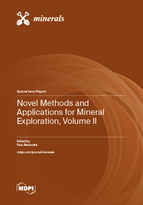Novel Methods and Applications for Mineral Exploration, Volume II
A special issue of Minerals (ISSN 2075-163X). This special issue belongs to the section "Mineral Deposits".
Deadline for manuscript submissions: closed (17 February 2023) | Viewed by 37636
Special Issue Editor
Interests: geochemical exploration; metallogeny; geostatistics; mineralogy; geochronology
Special Issues, Collections and Topics in MDPI journals
Special Issue Information
Dear Colleagues,
The mineral exploration industry is undergoing a profound transformation, reflecting not only some novel societal, economic, and environmental considerations, but also changes in the deposits themselves, which tend to be deeper, with lower grades, and in remoter regions. On the other hand, recent technological advances, not only in geophysics and geochemistry, but also in fields such as artificial intelligence, computational methods, and hyperspectral exploration, to name a few, have profoundly changed the way exploration in now conducted.
A very successful Special Issue of Minerals, "Novel Methods and Applications for Mineral Exploration", reflects some of these changes, and we now invite submissions to a second volume on the same topic. Of particular interest are manuscripts describing a novel exploration method or technique, and in particular those based on novel technological advances (e.g., artificial intelligence, computational methods, hyperspectral exploration), scientific advances (e.g., in geophysics and geochemistry), or novel data treatment and interpretation methodologies. A broad range of deposit types, commodities, and geographic regions will be considered. The intent is to achieve a comprehensive and timely anthology of the most advanced and recent developments in mineral exploration.
Dr. Paul Alexandre
Guest Editor
Manuscript Submission Information
Manuscripts should be submitted online at www.mdpi.com by registering and logging in to this website. Once you are registered, click here to go to the submission form. Manuscripts can be submitted until the deadline. All submissions that pass pre-check are peer-reviewed. Accepted papers will be published continuously in the journal (as soon as accepted) and will be listed together on the special issue website. Research articles, review articles as well as short communications are invited. For planned papers, a title and short abstract (about 100 words) can be sent to the Editorial Office for announcement on this website.
Submitted manuscripts should not have been published previously, nor be under consideration for publication elsewhere (except conference proceedings papers). All manuscripts are thoroughly refereed through a single-blind peer-review process. A guide for authors and other relevant information for submission of manuscripts is available on the Instructions for Authors page. Minerals is an international peer-reviewed open access monthly journal published by MDPI.
Please visit the Instructions for Authors page before submitting a manuscript. The Article Processing Charge (APC) for publication in this open access journal is 2400 CHF (Swiss Francs). Submitted papers should be well formatted and use good English. Authors may use MDPI's English editing service prior to publication or during author revisions.
Keywords
- mineral exploration
- economic geology
- exploration methodology
- geochemical exploration
- geophysical exploration
- novel exploration techniques
- modern exploration techniques
Related Special Issue
- Novel Methods and Applications for Mineral Exploration in Minerals (11 articles)






